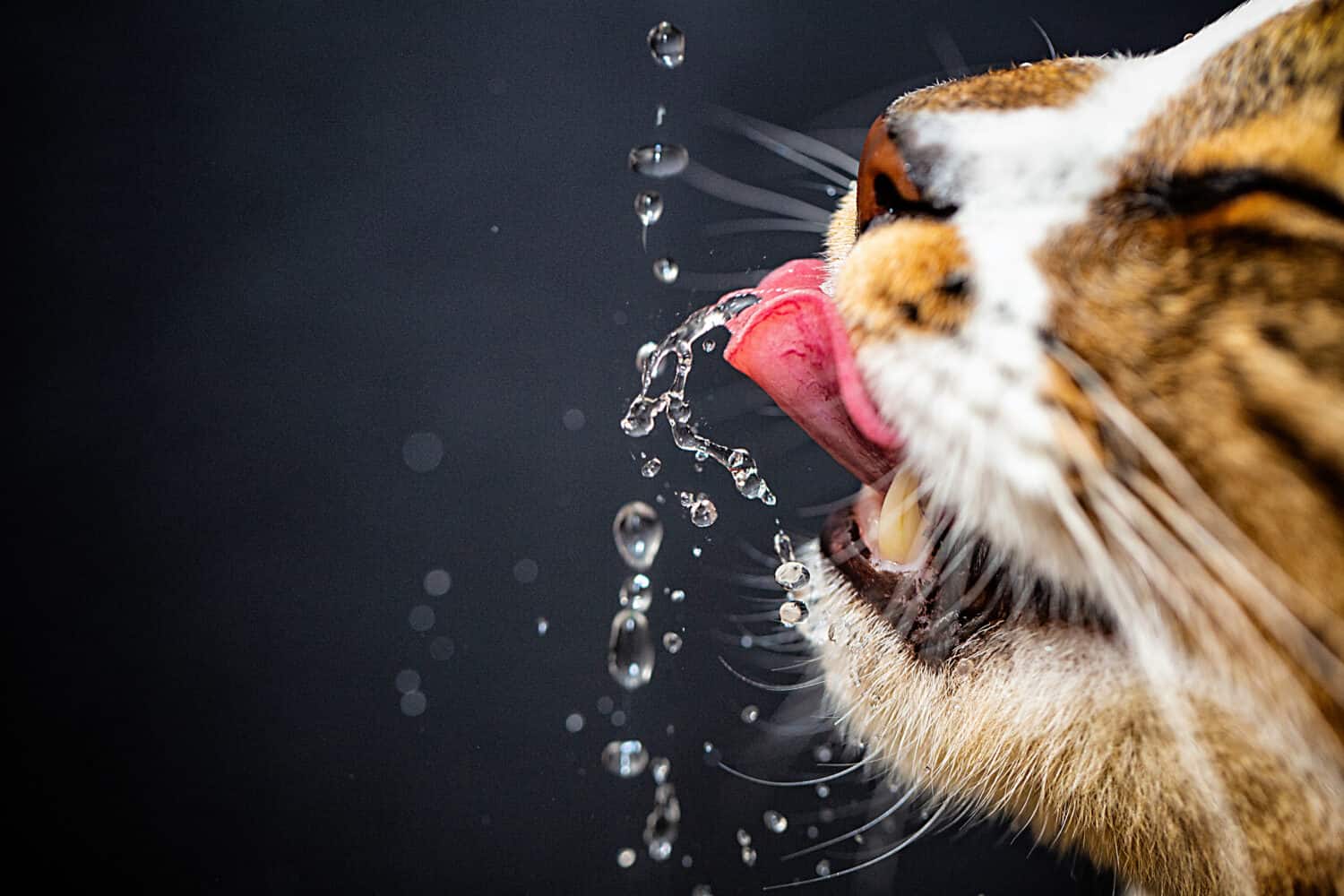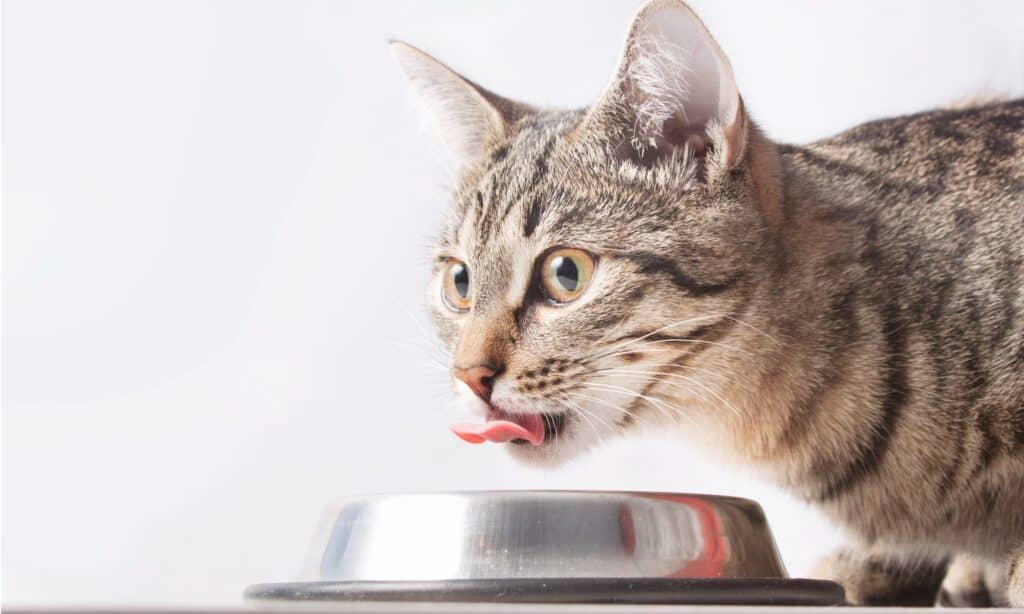There’s no worse feeling than coming home after a long day and seeing your cat’s water bowl empty. It can result in a pang of guilt, wondering how much time your cat had gone without. This might make you mentally ask yourself the question: Just how long can a cat go without water?
Cats are most frequently active during the late evening and early morning hours due to their crepuscular nature. This means that it can be hard to tell when exactly their water intake is highest. This behavior could potentially even cause concern that your cat isn’t consuming enough water. Whether you’re interested in knowing why you never see your cat drinking, you want to know the signs of dehydration, or you simply want to know the answer to how long a cat can go without water, this article will fill you in on all you need to know and then some.
How Long Can A Cat Go Without Water?

On average, your cat should consume roughly 1/4 cup of water per kilogram of weight daily.
©iStock.com/Lightspruch
To get things started, let’s answer the question in the short way and the long way. When it comes to the question “How long can a cat go without water,” the short answer is two to three days. If your cat has access to drinking water at some point within this period, that means that they’re likely to come out of the situation with their life. However, the long and more highly recommended answer is 24 hours. This is the amount of time it takes for dehydration to begin setting in. Therefore, from that point forward, the stakes become incredibly dire.
There’s no way to precisely measure your cat’s water intake, and frankly, there’s no need to. That being said, the general formula that veterinarians use to measure recommended intake is 1/4 cup of water per kilogram of the cat’s body weight daily. This is what is considered “normal,” but slightly more or slightly less water doesn’t mean something’s wrong.
How Long Can A Cat Go Without Eating?
Now that we’ve learned how long a cat can go without consuming any water let’s briefly discuss how this amount of time compares to eating. Much like humans, a cat can go far longer without food sources than without water. If a cat has steady access to quality water, it can have the potential to survive up to two weeks without food. That said, the cat would be in agony for the bulk of that time.
Generally speaking, cats are resilient animals. Non-domestic cats can likely hunt for food and successfully feed themselves with prey. This, however, does not extend to your housecat. Even if your cat has been gone a few days, never assume they’ve been feeding themselves. Being in the wild doesn’t mean being successful at it. Greet them with a bowl of their favorite food and plenty of affection.
Of course, with absolutely no water or food, a cat would only survive an absolute maximum of three days. Their body would rapidly deteriorate with the combination of no water and no protein. This is why it is essential to always keep your eye on your cat’s food and water intake to ensure they have healthy consumption levels.
Reasons Why Your Cat Isn’t Drinking Water

There are a variety of factors that can lead to the lowering of water consumption in your cat.
©AltamashUrooj/Shutterstock.com
It isn’t by any means abnormal to not notice your cat’s water consumption as well as you do with food. After all, when a cat is out of food, it’s likely they’ll be much more vocal about things! But once you do catch your cat avoiding the water bowl, it’s important to figure out why as quickly as possible.
Here are some of the most common explanations for a cat who’s willingly avoiding hydration:
- Exterior Stress: If you’re on vacation and the pet sitter notifies you that your feline friend isn’t drinking their water, it likely has more to do with you being gone rather than a health problem. Much like us, cats can sometimes feel overwhelmed and stressed out. When this happens, don’t be alarmed if they initially have some self-care avoidance.
- They’re Grossed Out: Cats aren’t strangers to cleanliness! Some might disagree, but cats can actually be very attentive to appearances. If your bowl hasn’t been cleaned in a while, that very well may be why your cat is avoiding it. Any gunk floating in the water might be enough to turn your cat away from that H2O.
- They Have Dry Food: Cats on an all-dry diet are actually known to drink a bit less water. Odd sounding but true!
- Pain/Medical Issues: An unfortunate explanation, sometimes cats avoid drinking because it’s causing them pain. If you rule out the other explanations, or if your cat is clearly dehydrated, take them to the vet immediately.
Signs A Cat is Dehydrated
In an instance where you’re certain your cat has been drinking less, it’s important to understand the signs of dehydration. The sooner that this issue is recognized, the more likely that the problem is fixable. Left untreated, it has the potential to severely harm a cat, sometimes even leading to the cat’s passing. To avoid this, take note of these symptoms:
- Less Elasticity: To test the elasticity of a cat’s skin, gently grab some of the skin on your cat’s shoulder and give it a tug. If it snaps back into its original spot immediately, that means your cat is fine. If it takes time to get into place, then the elasticity is low.
- Pale Tongue: When a cat’s tongue and gums are pale in color, this is a sign of a medical issue. It may be dehydration, but be aware that it could also be a sign of another illness.
- Sickly Eyes: If the eyes of your cat appear sunken and sickly, that is one of the most telltale signs of dehydration.
When in doubt, it’s better to be safe than sorry. Use the tips below to help you raise the water intake of the cat you believe to be suffering.
How to Help A Dehydrated Cat

If your cat has a low water intake, consider mixing broth into their dry food.
©iStock.com/Ukususha
The first, and perhaps most obvious, way to ensure your cat is getting a proper water intake is by providing them with accessible, clean water at all times. Don’t let them wait for you to refill the dish; always leave plenty for them to drink. If this doesn’t seem to be doing the trick, here are some other helpful ways to get your cat drinking more water:
- Provide Wet Food: If your cat won’t drink water in spite of having so much, maybe it’s time to switch. This way, your cat can hydrate while eating.
- Use Broth in Dry Food: If your cat is simply attached at the hip to their dry food, consider adding some broth. It will hydrate, provide nutrients, and make the meal even more tasty.
- Go to the Vet: In scenarios of extreme hydration, consider a trip to the vet. Your cat could benefit from a few rounds of IV fluids, as this is the fastest way to get its body the hydration it needs.
How Long Will It Take for A Dehydrated Cat to Recover?
This depends on a number of factors. If the dehydration was an isolated incident could come into play, as well as whether or not the cat had preexisting health conditions. In slight cases, the cat’s condition could improve overnight. In more severe cases, it will likely take several days.
Thank you for reading! Have some feedback for us? Contact the AZ Animals editorial team.







